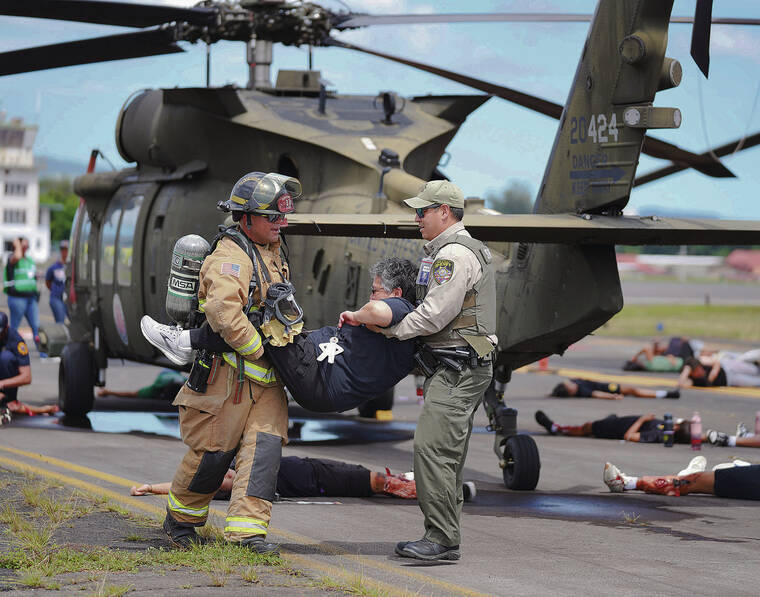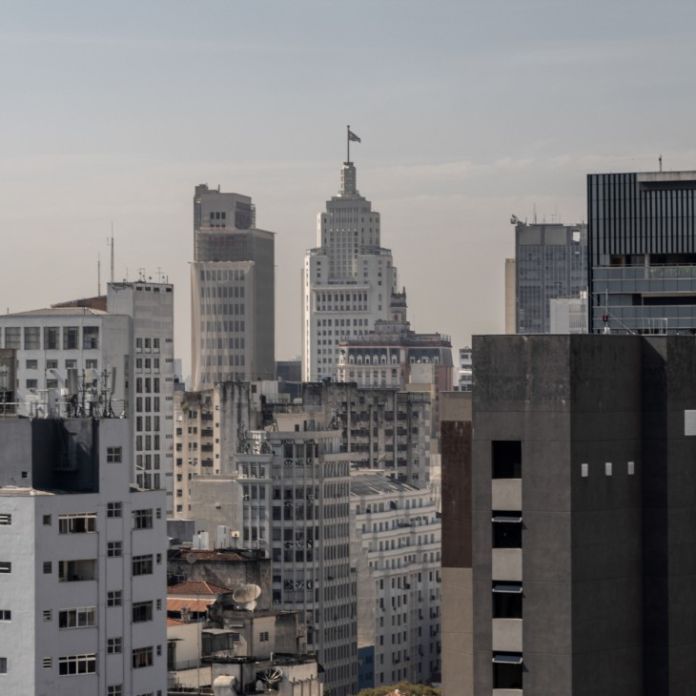By None
Copyright staradvertiser

What if two Boeing commercial airliners, a 717 and a 737, were to collide at Hilo International Airport?
That was the scenario which played out Thursday in what the Hawaii Department of Transportation called a full-scale exercise. The simulated disaster took place on the airport’s tarmac between the Civil Air Patrol hangar and the old airport control tower.
While it was business as usual, with scheduled flights arriving and departing on the airport’s runways, triage tents were quickly erected and firefighters dragged “patients” on skeds — stretchable plastic sleds — to those tents. There, the victims were tended to and then loaded into ambulances which took them to a location outside the airport fencing where Hilo Benioff Medical Center personnel staged a mock emergency room.
Two National Guard Helicopters — a CH-47 Chinook and a UH-60 Black Hawk — stood in for the crashed Boeing 717 and 737, respectively.
“We have 10 deaths and 70 injured,” said Lt. Newton Miller of Hilo Airport Rescue Firefighters of the simulated exercise, a triennial requirement by the Federal Aviation Administration.
The drill involved airport personnel and local agencies working together to test and evaluate interagency communications, response plans and responders’ actions.
“Once we’re done suppressing the fire, we do our quick triage,” Miller said. “We have our maintenance crew that brings out our medical trailer — those are our green, yellow and red tents, and later, the black. This lull we’re in, because of our resources on the Big Island, sometimes we won’t get HFD coming in right when things happen. But they come in, they help with patient removal from the hot zone into our triage tents.
“We have a couple of ambulances running through, picking up patients in triage and taking them up to the hospital.”
The exercise was carried out by multiple agencies’ assets and personnel. In addition to airport staff and the agencies already mentioned, participating organizations include: airlines, FAA, Transportation Security Administration, Hawaii Police Department, Hawaii Fire Department, Red Cross, Hawaii County Civil Defense, Hawaii Air National Guard, Hawaii Emergency Management Agency, Keaau High School, Youth Challenge and Job Challenge academies and American Medical Response.
Four triage tents were erected in what seemed mere moments on the tarmac. There was a green tent for those “passengers” fortunate enough to be ambulatory after the collision. A yellow tent was set up to tend to those mildly to moderately injured. A red tent served the injured Miller described as “get them to the hospital, fast.” And behind an airport fire tanker near the deserted former flight tower stood a black tent for those who died.
Volunteers portrayed passengers in distress.
“I was voluntold,” quipped Maka Moepono, a 19-year-old Mauian and associate at the Hawaii National Guard Job Challenge Academy. Moepono, an aspiring tattoo artist and Youth Challenge Academy graduate, understands the meaning of “volunteer” in a military environment.
“It was an interesting experience. I was really impressed that they could actually lift me,” she said and laughed. “When they were pulling me on the sled, it was kind of hot on my back. But it was really good to be a part of the drill and learn this kind of stuff.”
Another of the volunteer patients, Tomasi Veimau, is an 18-year-old senior at Keaau High School who attended Ho‘omau Fire Academy over the summer.
Veimau said he was impressed at how the firefighters “move in sections” during triage.
“They take care of one part first, take care of the more hurt people,” he said.
Asked about his sked ride, Veimau replied, “It was kind of hot, but it wasn’t too bad.”
“They just dragged me. It was kind of fun,” he said.
Veimau, who has a modified schedule at the high school, took part in the exercise on a day off, with good reason.
“I want to go to college to play football and study fire science, and then, I want to come back home and be a firefighter.”
A third volunteer patient, Ka‘iana Miller, is a 16-year-old junior at Keaau High School, where he plays basketball. He, like Veimau, also attended Ho‘omau Fire Academy.
Miller, the son of the airport fire lieutenant, called the exercise “a pretty fun experience.”
“It was very hot, so like, I really wanted water. But everything else was pretty cool,” he said. “Seeing how all these firefighters operate was really an eye-opening experience to see how everybody comes together in times of need.”
And like Veimau, the younger Miller also saw the value of the exercise in the context of his future plans.
“The fire academy opened me up to the experience of maybe becoming a firefighter, but my plan was always to become a pilot. I’d rather become a pilot,” he said.



